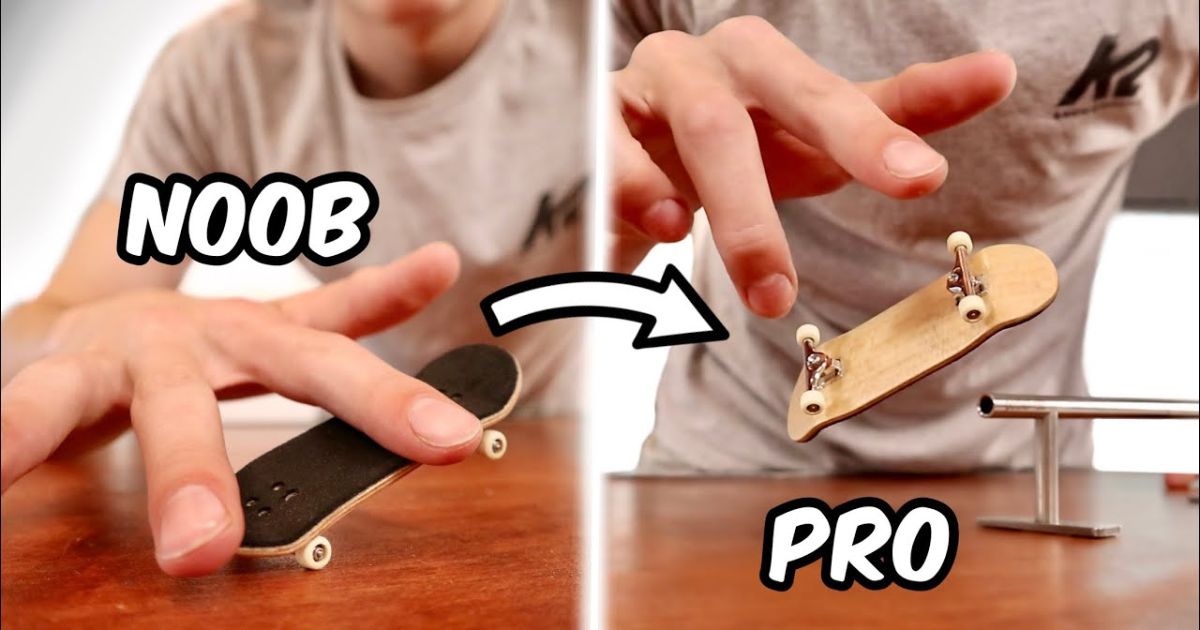What is a Tech Deck?
A Tech Deck is a miniature replica skateboard that has gained immense popularity among skateboarding enthusiasts and collectors alike.
These finger-sized skateboards are designed to simulate real skateboarding tricks using just your fingers.
Originally introduced in the late 1990s, Tech Decks have evolved from simple toys to sophisticated fingerboarding tools used by both beginners and professionals in the finger skateboarding community.
Understanding the Basic Components
The Deck Structure
The foundation of any Tech Deck lies in its carefully crafted components. The deck itself is typically constructed from high-quality wood or durable plastic, measuring approximately 96mm in length.
Each deck features realistic skateboard graphics and comes equipped with proper grip tape on top, providing the necessary friction for executing tricks like the ollie.
The scaled-down design maintains the authentic feel of a real skateboard, complete with a concave shape that aids in trick execution.
Hardware and Wheels
The technical aspects of a Tech Deck include professional-grade miniature trucks, wheels, and bearings.
The trucks are metal components that attach to the deck and hold the wheels in place, allowing for smooth movement and precise control during fingerboard tricks.
The wheels are made from specialized materials that provide the right amount of grip and roll, essential for performing tricks like the ollie and other advanced maneuvers.
Preparing for Your First Ollie

Proper Finger Positioning
Before attempting the ollie, mastering the correct finger placement is crucial for successful finger skateboarding.
Your index finger should be positioned near the middle of the deck, while your middle finger rests on the tail.
This positioning mirrors the foot placement on a real skateboard and forms the foundation for executing the perfect Tech Deck ollie.
Maintaining consistent finger placement helps develop muscle memory, making the trick more natural and fluid over time.
Practice Surface Selection
Choosing the right surface for practicing your fingerboard ollie technique is often overlooked but extremely important.
A smooth, flat surface provides the ideal foundation for learning. Many enthusiasts prefer using specialized fingerboard parks, but a clean desk or table works well for beginners.
The surface should offer enough grip to prevent unwanted sliding while allowing the wheels to roll smoothly during trick execution.
Step-by-Step Ollie Guide
Initial Position
The starting position is crucial for a successful Tech Deck ollie. Position your fingerboard parallel to your body, ensuring both trucks are level with the surface.
Your index finger should rest just behind the front truck bolts, while your middle finger applies slight pressure to the tail.
This setup position is fundamental to all Tech Deck beginner tricks and serves as the launching point for more advanced maneuvers.
The Pop Motion
The pop is the first active movement in performing an ollie. Using your middle finger, apply quick, sharp pressure to the tail, causing it to strike the surface.
This motion creates the initial lift necessary for the trick. The key is to maintain control while generating enough force to elevate the entire board.
Many beginners struggle with finding the right balance, but consistent fingerboard ollie practice helps develop the perfect pop pressure.
The Slide and Level
As the board rises from the pop, your index finger performs a sliding motion toward the nose of the deck.
This movement mirrors the foot slide in real skateboarding and helps level out the Tech Deck in mid-air.
The slide requires precise timing and pressure control, making it one of the more challenging aspects of Tech Deck trick tips to master.
The goal is to create a smooth, fluid motion that brings the board to a level position at the peak of the ollie.
The Landing
A clean landing completes the ollie sequence. As the board levels out, guide it back to the surface while maintaining control with both fingers.
The front wheels should touch down first, followed by the back trucks, creating a smooth rolling motion.
Proper landing technique prevents the board from bouncing or sliding out, ensuring you maintain control for linking multiple tricks together.
Common Mistakes and Solutions
Inconsistent Pop
One of the most frequent issues beginners face when learning Tech Deck skateboarding is an inconsistent pop. This often results from applying too much or too little pressure to the tail.
The solution lies in practicing the pop motion in isolation, focusing on finding the sweet spot that provides enough lift without causing the board to flip or rotate uncontrollably.
Regular practice sessions dedicated to pop consistency will significantly improve your overall ollie success rate.
Poor Finger Control
Maintaining precise finger control throughout the ollie motion challenges many newcomers to finger skateboarding basics. Shaky or uncertain finger movements can lead to unsuccessful attempts and frustration.
Developing stronger finger dexterity through targeted exercises and gradual practice helps overcome this obstacle. Start with slow, controlled movements and gradually increase speed as your confidence grows.
Timing Issues
Proper timing between the pop and slide movements is essential for a successful Tech Deck ollie. Many beginners either rush the sequence or hesitate too long between movements.
Breaking down the trick into its component parts and practicing each segment separately helps develop better timing awareness. Once comfortable with individual elements, combining them into a fluid motion becomes more natural.
Advanced Ollie Variations

Height Control
After mastering the basic ollie, controlling the height of your tricks opens new possibilities in Tech Deck skateboarding. Height variation comes from adjusting the pop force and slide timing.
Higher ollies require more explosive pop motion and quicker slide mechanics, while lower, controlled ollies rely on subtle movements and precise finger control. Practicing height variations adds versatility to your fingerboard tricks arsenal.
Direction Management
Incorporating different directions into your ollie repertoire expands your trick possibilities.
Learning to ollie while moving forward, backward, or at angles requires adjusting your finger positioning and pop mechanics.
These variations build upon the fundamental fingerboard ollie technique while adding complexity and style to your tricks.
Combining with Other Tricks
The ollie serves as a gateway to more complex Tech Deck combinations. Once comfortable with the basic motion, experiment with adding rotations, flips, or grinds to your ollies.
These combinations require advanced finger control and timing but significantly expand your trick vocabulary.
Start with simple additions and gradually progress to more challenging sequences as your skills improve.
Maintenance and Care
Cleaning Your Tech Deck
Regular maintenance ensures optimal performance for your Tech Deck. Clean the wheels, trucks, and bearings periodically to prevent dirt and debris from affecting trick execution.
Use appropriate cleaning solutions and tools designed for miniature skateboard components. Proper maintenance extends the lifespan of your equipment and maintains consistent performance during fingerboard ollie practice.
Equipment Checks
Before each practice session, inspect your Tech Deck for any loose components or wear that might affect trick performance.
Check the truck tightness, wheel spin, and deck condition. Regular equipment maintenance prevents unexpected issues during trick attempts and ensures consistent performance while learning and practicing new Tech Deck trick tips.
Building a Practice Routine
Setting Goals
Establishing clear objectives helps structure your Tech Deck practice sessions. Set specific goals for ollie height, consistency, and variation mastery.
Track your progress and adjust your practice routine accordingly. Goal-setting provides motivation and direction while learning fingerboard tricks and helps maintain focus during practice sessions.
Progressive Learning
Advance your skills systematically by following a structured progression in your finger skateboarding basics.
Start with stationary ollies, then move to rolling ollies, and gradually incorporate variations and combinations.
This methodical approach builds a solid foundation for more advanced Tech Deck techniques while minimizing frustration and maintaining motivation.
Community and Resources
Online Learning
The internet offers abundant resources for improving your Tech Deck ollie tutorial skills.
Video tutorials, online communities, and social media platforms provide valuable insights and inspiration.
Engage with other enthusiasts, share experiences, and learn from experienced practitioners to accelerate your progress in finger skateboarding.
Local Scene
Many areas have active fingerboard communities that organize meetings and competitions.
Participating in local events provides opportunities to learn new techniques, share Tech Deck trick tips, and connect with fellow enthusiasts.
The community aspect of fingerboarding adds a social dimension to the hobby while providing valuable learning opportunities.
Frequently Asked Questions (FAQs)
How do you ollie a Tech Deck?
Place your index finger near the middle of the Tech Deck and middle finger on the tail. Pop the tail with your middle finger while sliding your index finger forward, then level the board and land smoothly to complete the ollie.
How do you flip a tech deck for beginners?
For a basic kickflip, position your fingers as you would for an ollie, but when popping the tail, slide your index finger off the side of the board instead of straight forward to create rotation. Start slowly and practice the fingerboard tricks with controlled movements.
How to do a jump with a tech deck?
Master the basic ollie motion by popping the tail with your middle finger while guiding the board upward with your index finger. The height depends on pop force and timing. Practice this fundamental mini skateboard ollie until you achieve consistent jumps.
How do you ride a tech deck?
Place your index finger near the front truck and middle finger over the back truck. Apply gentle, alternating pressure to roll the board forward. Start slow and practice these finger skateboarding basics on a flat surface.
Is Tech Deck wood?
Tech Decks come in both wood and plastic varieties. Professional models often use wood for better feel and pop, while standard versions use durable plastic. Both materials work well for Tech Deck trick tips, with wood preferred by advanced users and plastic ideal for beginners.
Conclusion
Mastering the ollie on a Tech Deck requires dedication, patience, and consistent practice. Understanding the fundamental techniques, avoiding common mistakes, and following a structured learning approach will help you progress from basic movements to advanced variations.
Remember that every expert fingerboarder started as a beginner, and with persistent practice and proper technique, you can achieve impressive results in your finger skateboarding journey.
Continue exploring new variations, connecting with the community, and most importantly, enjoying the creative and challenging aspects of Tech Deck skateboarding.
Vividcrest admin brings expert insights in Tech and Gaming, offering up-to-date content, in-depth analysis, and trends to keep you ahead in the digital world.








